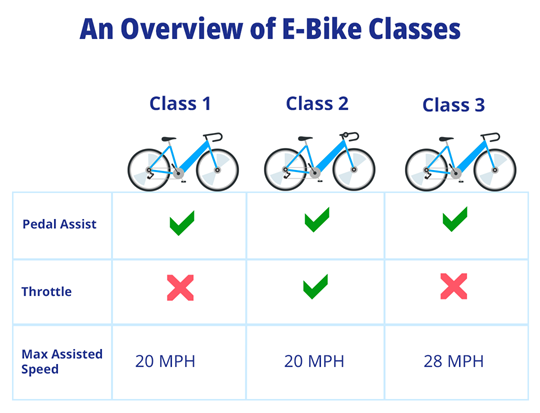Information about E-Bikes

What are e-bikes?
E-bikes or electric-assist bicycles are bicycles with a motor that is powered by a battery. Because they make travel easier, e-bikes are becoming more popular in Cambridge.
E-bikes can make it easier for more people to get around the city, which can help reduce car traffic; they also have health benefits for the rider. E-bikes are battery-powered, which makes them faster and heavier than regular pedal bikes. This means that people who ride e-bikes should be extra careful to keep themselves and others safe on the road.
For a quick overview of e-bikes, see this infographic.
Translated versions of the infographic are also available here: Amharic | Arabic | Bangla | Chinese | Haitian Creole | Japanese | Korean | Portuguese | Somali | Spanish
How does Massachusetts define e-bikes?
Massachusetts state laws include definitions of classes (categories) and regulations for e-bikes. The regulations for e-bikes are almost the same as those for regular (pedal) bikes. One important difference is that e-bikes are not allowed on sidewalks.

Class 1 e-bike: Has an electric motor of 750 watts or less that assists only when the rider is pedaling, and can go up to 20 mph.
Class 2 e-bike: Has an electric motor of 750 watts or less that assists only when the rider is pedaling or using a hand-throttle, and can go up to 20 mph.
Class 3 e-bike: Has an electric motor that assists only when the rider is pedaling and can go up to 28 mph. Class 3 is not defined in the Massachusetts law but is still legal to use.
Each class comes with specific rules, and changing an e-bike in a way that pushes it out of its designated class may make it illegal. Changes may also void the warranty. In Massachusetts, it is not allowed to make after-purchase changes to the motor power or speed of an e-bike or change the way it moves forward (pedal or throttle assist).
General FAQs
Where may I ride an e-bike in Massachusetts?
Almost anywhere you could currently ride a regular (pedal) bicycle.
- On roadways and in bike lanes.
- On most bike paths & paved trails (check local rules and signage). All paths and trails in Cambridge currently allow e-bikes.
- Not allowed on sidewalks.
- Not allowed on unpaved trails, unless a sign says e-bikes are allowed.
When should I use an e-bike?
E-bikes are especially appealing to people who want to bike longer distances, who ride in hilly areas, who want to carry heavy loads and/or children, or to anyone who may need some extra support, including seniors and people with disabilities.
Why should I use an e-bike?
- Better for fitness and health than driving.
- More eco-friendly and costs less than a car to drive and maintain.
- No license required in Massachusetts.
- Easier to move through traffic.
- Requires less effort to ride than regular bicycles (less fatigue and sweat).
Important Safety Tips
What are the risks of riding an e-bike?
- Speed: Higher speeds mean there is a greater chance of serious injury to the rider or other road users.
- Weight: E-bikes are usually heavier than regular (pedal) bikes. This makes them harder to stop and more difficult to handle when moving.
- Lack of rider experience and knowledge: New riders may not have the necessary skills to navigate turns, maintain balance, and react quickly to changing road conditions.
With greater speed comes greater responsibility
E-bikes don’t look very different from regular bikes, but they go much faster, which may be surprising and scary for other road users. Faster speeds on a heavier bike mean that a crash can be more serious. This increases the risk to the rider, other cyclists, and pedestrians.
- If you are new to riding an e-bike, practice in an open space or where there is less traffic.
- Ride slowly in busy places and be careful around people walking. Remember to let other riders and pedestrians know when you’re passing them.
- Always stop for pedestrians crossing the street.
- Be respectful and careful around others, especially children, seniors, and people with disabilities.
- Be careful at intersections.
- Drivers may not see fast approaching e-bikes, even if they check before making a turn.
- It takes only one person to prevent a crash, regardless of fault. It can be you!
- Pay attention to what’s ahead of you and slow down if your view of side streets or driveways is blocked.
Follow the same safety practices as regular bicyclists
- Ride predictably, so that others know what to expect from you.
- Check behind you before turning or changing lanes.
- Signal before making a turn.
- Do not weave in and out of lanes.
- Wear a helmet.
- Be visible (use lights and reflectors).
E-Bike Battery Safety

Most e-bikes (and e-scooters) are powered by lithium-ion (non-alkaline) batteries. This is the same type of battery that powers many of today's electric cars, cell phones, laptops, and power tools. When lithium-ion batteries are damaged, they can overheat, catch fire, and even lead to explosions. When fires occur, they also tend to burn very hot and can be difficult for firefighters to extinguish.
There are a few ways to reduce the risk of fires involving e-bikes and e-scooters.
- Buy bikes with batteries that meet safety standards UL 2849 or EN 15194.
- Follow charging instructions that come with the bike.
- Disconnect the battery from the charger once it's fully charged.
- Never use charging equipment that didn't come with your bike.
- Stop using your e-bike if the battery shows signs of damage (if it has an unusual odor, changes in color, gets too hot, changes in shape, begins to leak or smoke, or does not hold a charge).
- If your bike needs repairs, take it to a qualified professional.
For more details about lithium battery safety, see this information from the Cambridge Fire Department.
E-Bike Buying Tips
What options do I have for e-bikes?
E-bikes come in many different models and types. Some key features to consider when choosing an e-bike:
Safety/Quality
- Look for one that meets UL 2849 or EN 15194 safety standards.
Battery
- Removable: an easily removal battery allows for storing and charging indoors, and for swapping with a spare battery.
- Built-in: batteries that are integrated into the bike frame are harder to steal and better protected from rain and dirt.
Model
- Foldable: easier to carry and store.
- E-cargo bike: carries passengers and/or cargo.
- E-tricycle: 3-wheel model; may be a good choice for people who need help with endurance, balance, or coordination.
- Custom-fit adaptive bike: specially fitted for people with certain types of disabilities or long-term health conditions.
- Electric handcycle wheelchair attachment: a device that turns a manual wheelchair into an electric-powered handcycle.
Frame Style
- Step over.
- Step through (low-instep): may be a good choice for people who need help with endurance, balance, or coordination.
Gears and Gear Shifters
Gears and gear shifters make it easier and more comfortable to adjust to different terrains (uphill, downhill, flat level). There are three main types of e-bike gears:
- Derailleur gears. These external gears sit in the center of the bike’s rear wheel. They are lightweight and generally inexpensive to repair. Derailleurs offer a wider range of gearing options than most hub gears.
- Hub gears. These gears sit in an internal hub on the bike’s rear wheel. They’re low maintenance since they don’t have exposure to the elements like derailleur gears. Most hub gears offer fewer gearing options than derailleur gears.
- Single-speed gears. These have only one mechanical gear and are most suitable for flat terrain riding. They’re low maintenance and easier for those who don’t want to deal with the complexities of shifting gears.
Talk to an expert to help decide what bike model and features are best for you!
Where can I buy an e-bike?
E-bikes can be bought at a local bike shop, at a big-box store, or online. Buying an e-bike at a big box store or online is often less expensive and may offer more choice, but has some drawbacks:
- It typically comes unassembled so you would need to put it together.
- Online vendors have a larger choice of brands and models than a shop, but choices may be overwhelming, and the quality of the bikes may vary.
- Getting expert advice for your specific needs at a big box store or online may be difficult.
- You cannot easily try different types of bikes before buying one online or at a big-box store.
- Local bike shops may not be able to do maintenance and repairs for bikes bought elsewhere.
It may be helpful to try riding an e-bike before buying one. You can do this by renting an e-bike, borrowing one from a friend or from the E-bike Lending Library, or trying an electric model from the Bluebikes bikeshare program.
Storing an E-Bike
Before buying an e-bike, it is important to think about where you would store it.
- E-bikes are expensive and to protect them from theft it is best to store them in a secure location, such as a garage, basement, shed, or apartment storage unit. Most e-bikes are too big and heavy to carry up stairs. Foldable models are easier to carry because they weigh a bit less and are more compact.
- Batteries need to be kept in a clean and dry place, between 32 to 68 degrees Fahrenheit. Removable batteries can be brought inside.
- To protect your bike from theft when it is parked outside, or inside in shared storage, use a secure lock. No locks protect 100%, but your bike is less likely to get stolen if you have a good lock. It’s best to have a lock that is secure enough to protect your bike and easy enough to use on a daily basis.
- Good choices are a U-lock (ideally with flex cable) or a heavy-duty chain lock (with sleeve). A heavy-duty chain lock gives more protection but is also much heavier to carry.
- Make sure you securely attach your lock to a solid object that cannot be lifted over.
- Lock your bike in a well-lit area with high foot traffic.
- Do not lock your bike to anything that can be cut, like a wooden fence.
What if owning an e-bike is not for me?
If storing or maintaining your own e-bike sounds too challenging, you may want to consider using an e-bike through the Bluebikes public bikeshare program instead. You will still be able to enjoy most of the benefits of using an e-bike!